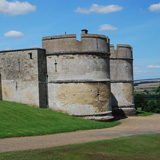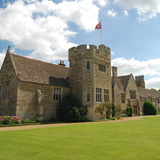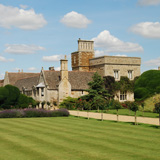History
Rockingham Castle is situated on elevated ground, affording it a strategic position over the Welland Valley. This is why the location has been used for defense since the Iron Age. The first castle was built here by William the Conqueror in the 11th century, shortly after the Battle of Hastings, probably between 1068 and 1071. The original castle was a wooden motte-and-bailey castle.

Rockingham Castle followed the standard Norman castle design, featuring a wooden keep, an outer bailey that contained square towers, a Great Hall, a chapel, and living quarters for the garrison. A second bailey was located on the opposite side of the motte. Within 30 years, William II replaced the wooden castle with a stone one, adding a large keep to the motte and enclosing the outer bailey with a curtain wall. The castle served as a royal retreat and an administrative center, as the nearby Rockingham Forest was renowned for its abundance of wild boar and deer.
In 1095, William II and Anselm, the Archbishop of Canterbury, attended a church-state council held at the castle to address the issue of episcopal appointments and debate the Church's allegiance to both the Pope and the King; however, no resolution was achieved. King John would visit the castle four times.
In 1270, Henry III added the twin-tower Gatehouse. Other improvements were carried out by his son, Edward I, who spent enormous sums of money modernizing the castle by adding fireplaces and windows to the Great Hall and a bedroom for Queen Eleanor. He also replaced the square towers with round towers. Edward III would be the last monarch to visit Rockingham Castle while in royal possession in 1375.
In the 15th century, Rockingham Castle had fallen into ruin, and Sir Edward Watson acquired the lease of the castle from Henry VIII. Edward was the founder of the Watson dynasty. Some parts of the castle were then replaced with a Tudor-style house and gardens as the castle transitioned from a royal palace to a hunting lodge for the nobility. Edward Watson's grandson, Lewis Watson, acquired the freehold of the castle and lands from King James I in 1619. Lewis would later become a knight, baronet, and baron.
In the 1640s, Rockingham Castle was garrisoned by Royalist troops during the English Civil War. From this location, they launched a few minor skirmishes against Parliamentary forces. In 1643, the castle was captured by Parliamentary troops led by Lord Grey of Groby, 1st Earl of Stamford, and Lewis Watson was forced to surrender. In 1646, the walls of Rockingham Castle were slighted to make it indefensible.
In 1836, Richard Watson and architect Anthony Salvin modernized Rockingham Castle and added the Flag Tower, now called Salvin's Tower. Richard and his wife were good friends with Charles Dickens, who visited the castle on five occasions. The castle remains home to the Watson family to this day.
Castle Highlights
Rockingham Castle is lovely to visit as you can see both Norman and Tudor style architecture in the same castle. However, before visiting, please check their schedule, as they are only open a few days a week in the summer, as the castle remains the home of the Watson family.
The Gatehouse and its round twin towers and arrow slits are the best part of the old castle to see. The castle's interior includes the Great Hall, which is much smaller today than in the time of Edward I, as the room was later divided into a reception room and a central dining room. Two iron chests are located in the Great Hall. A round-topped chest is reputed to belong to King John, who left it here before his ill-fated journey across the Wash in which he lost the Crown Jewels. The other chest bears the arms of King Henry V, who visited the castle in 1413 and 1422.
Salvin's Flag Tower is also quite distinctive as it rises above the Tudor roofline. A steep spiral staircase leads up the tower to a small room known as the Armoury, which Charles Dickens used as the model for Mr. Tulkinghorn's Chamber in Bleak House.
Rockingham Castle has a lovely formal garden within the outer bailey. You can spend half a day or more visiting Rockingham Castle. If time permits and you want to see more castles on the same day, Oakham Castle is close enough, just a few miles to the North.
Rockingham Castle may also be haunted.



